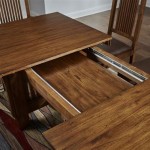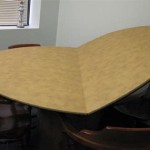How To Restain An Old Coffee Table
Restaining an old coffee table can breathe new life into a worn piece of furniture, allowing it to better complement existing décor or acquire a completely new aesthetic. This process involves careful preparation, the application of a new stain, and protective finishing, all of which contribute to a durable and visually appealing result. The following outlines a comprehensive approach to restaining a coffee table, ensuring satisfactory and long-lasting results.
Assessing the Coffee Table's Condition
Before embarking on the restaining project, a thorough assessment of the coffee table's condition is crucial. This involves identifying existing damage, understanding the current finish, and determining the wood type. Damage can range from minor scratches and dents to significant water damage or veneer peeling. The type of existing finish, whether paint, varnish, lacquer, or stain, will influence the preparation methods required. Identifying the wood species will inform the choice of stain, as different woods absorb stain differently and exhibit varying grain patterns.
Minor scratches and dents can often be addressed with wood filler. Deep gouges or significant damage might require more extensive repairs, such as wood replacement. Water damage can cause warping or discoloration, which may necessitate sanding and potentially the use of wood bleach. Veneer peeling requires careful application of wood glue and clamping to re-adhere the veneer to the substrate. If the veneer is extensively damaged, replacement might be the only viable option.
Determining the existing finish can be achieved through visual inspection and simple tests. Paint will be opaque and completely obscure the wood grain. Varnish and lacquer typically create a hard, glossy finish that sits on top of the wood. Stain penetrates the wood and enhances the grain, leaving a more natural appearance. A simple test involves applying a small amount of denatured alcohol or lacquer thinner to an inconspicuous area. If the finish softens or dissolves, it is likely lacquer or varnish. If it remains unaffected, it could be a more durable coating like polyurethane or paint.
Identifying the wood species is important for predicting how the wood will accept stain. Hardwoods like oak, maple, and cherry have closed grain patterns and tend to absorb stain more evenly. Softwoods like pine and fir have open grain patterns and can be more prone to blotching. Applying a wood conditioner before staining can help mitigate blotching in softwoods.
Preparing the Surface for Restaining
Proper preparation is paramount for achieving a professional-looking finish. This involves removing the existing finish, sanding the surface to create a smooth and even base, and cleaning the wood to remove dust and debris. The specific methods used will depend on the type of existing finish, the condition of the wood, and the desired outcome.
Removing the existing finish can be accomplished through several methods, including chemical stripping, scraping, and sanding. Chemical stripping involves applying a chemical stripper to the surface, allowing it to soften the existing finish, and then scraping it away with a putty knife or scraper. This method is effective for removing multiple layers of paint or varnish but requires careful ventilation and the use of appropriate safety gear, such as gloves and eye protection. Scraping involves using a sharp scraper to remove the finish, which can be effective for removing loose or peeling finishes but requires skill to avoid damaging the wood. Sanding involves using sandpaper and a sanding block or power sander to remove the finish. This method is suitable for removing thinner finishes and creating a smooth surface for restaining.
After removing the existing finish, sanding is essential to create a smooth and even surface. Start with a coarser grit sandpaper, such as 80-grit or 100-grit, to remove any remaining finish and level out imperfections. Progress to finer grits, such as 150-grit and 220-grit, to refine the surface and prepare it for staining. Sand in the direction of the wood grain to avoid creating scratches that will be visible after staining. A random orbital sander can be used for large, flat surfaces, while a sanding block is better suited for edges and corners. Hand-sanding might be necessary for intricate details or hard-to-reach areas.
Once the surface is sanded, thoroughly clean the wood to remove dust and debris. Use a vacuum cleaner with a brush attachment to remove loose dust, followed by a tack cloth to pick up any remaining particles. A tack cloth is a sticky cloth that effectively removes fine dust without leaving residue. Ensure that the surface is completely clean and dry before proceeding to the staining process.
Applying the Stain and Finishing Touches
The application of the stain is where the coffee table's new appearance begins to take shape. Selecting the right stain color and application method are critical for achieving the desired aesthetic. After the stain is applied, a protective topcoat is essential for durability and longevity.
Selecting the stain color is a matter of personal preference, but it is important to consider the existing décor and the wood species. Test different stain colors on a small, inconspicuous area of the coffee table to see how they look on the wood. Keep in mind that the stain color will appear darker on softer woods and lighter on harder woods. Water-based stains tend to be more environmentally friendly and easier to clean up, while oil-based stains offer better penetration and durability.
The stain can be applied using a brush, rag, or foam applicator. When using a brush, apply the stain evenly in the direction of the wood grain. Avoid applying too much stain at once, as this can lead to blotching or uneven coverage. When using a rag or foam applicator, dip it into the stain and wipe it onto the surface, again following the wood grain. Allow the stain to penetrate the wood for the recommended time, as specified by the manufacturer. This can range from a few minutes to several hours, depending on the stain type and desired color intensity. After the specified time, wipe off any excess stain with a clean rag. This will prevent the stain from drying on the surface and creating a sticky or uneven finish.
Once the stain is completely dry, apply a protective topcoat to seal the wood and protect it from scratches, stains, and moisture. Polyurethane is a popular choice for coffee tables due to its durability and resistance to water and chemicals. Varnish and lacquer are also viable options, offering different levels of sheen and durability. Apply the topcoat in thin, even coats, following the manufacturer's instructions. Allow each coat to dry completely before applying the next. Lightly sand between coats with fine-grit sandpaper, such as 320-grit or 400-grit, to remove any imperfections and create a smooth surface for the next coat. Apply at least two coats of topcoat for adequate protection.
After the final coat of topcoat is dry, allow the coffee table to cure for several days before placing items on it. This will allow the finish to fully harden and prevent damage. Consider adding felt pads to the bottom of the legs to protect flooring from scratches. Regular cleaning with a soft cloth and furniture polish will help maintain the coffee table's appearance and prolong its life.

Refinishing A Coffee Table The Craftsman Blog

How To Refinish A Table Farmhouse Style My 100 Year Old Home

Wooden Coffee Table Makeover Little Glass Jar

How To Refinish And Stain Wood Roots Wings Furniture Llc

Old Thrift Coffee Table Transformed With Chalk Paint Polyshades Artsy Rule

Refinished Coffee Table

How To Refinish And Stain Wood Roots Wings Furniture Llc

Farmhouse Coffee Table Makeover Unoriginal Mom

How To Restain Wood Without Stripping So Simple Artsy Rule

Refinished Coffee Table








